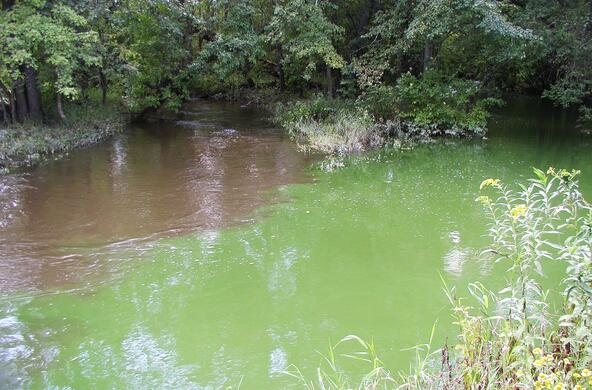It can look like scattered green dots, long green streaks, pea soup, or spilled green paint, but it always means one thing: algal bloom season has arrived, coating many Hudson Valley lakes and ponds in a toxic layer of algae that can be harmful to humans when touched or swallowed and potentially fatal for dogs and wildlife.
It’s fairly common in late summer for regional bodies of water to be closed for swimming, fishing, and boating as a result of HABs. However, it’s not only recreation that can be impacted. Last month, the Melzingah reservoir, which provides drinking water to Beacon residents, experienced an unprecedented algal bloom.
“The interesting thing is we have not had algal blooms there in the past,” says Beacon City Administrator Chris White. As for what caused this bloom, White says he can only speculate but that quick water warm-ups from bouts of hot weather may have contributed.
White says that although the Melzingah is always off-limits for swimming and boating because it’s a water source, signage was posted anyway to warn people of the toxic bloom, which was detected on July 19. The reservoir still remains offline.
Because Melzingah is smaller than other reservoirs in Beacon, it’s typically only used earlier in the season. Once its levels are drawn down, the city switches to its two wells in Fishkill and other two reservoirs, the Cargill Reservoir and the Mount Beacon Reservoir, for drinking water. That had already happened when the bloom was discovered, and both of the in-use reservoirs are near-capacity and HAB-free.
“We’re doing fine,” says White.
Why HABs happen
Although harmful algal blooms (HABs) are commonplace and the New York State Department of Environmental Conservation (DEC) says they are not happening with increased frequency currently, some scientists worry that climate change could cause HABs to happen more often in coming years.
A combination of warm water and high nutrient levels — caused by agricultural fertilizer or wastewater runoff — produce HABs, and blooms occur most often in the late summer when water conditions are at their warmest. HABs vary in appearance and coloration, sometimes appearing blue-green or white. People who eat food contaminated by HABs — for example, fish from a body of water with an HAB — or swallow contaminated water can become ill with stomach pain, headache, muscle weakness, dizziness, vomiting, diarrhea, and liver damage. For dogs, a drink or a swim in HAB-covered water can be lethal.
Regional bodies of water that have had reported blooms in the recent weeks include Iroquois Lake in Schenectady County; Schor Pond in Columbia County; Sleepy Hollow Lake in Greene County; and Lake Mohegan in Westchester County.
The bloom in Beacon’s Melzingah reservoir, one of the city’s drinking water sources, is a first-time occurrence.
White says Beacon is considering some mitigation measures for Melzingah, such as an aeration system to oxygenate and stir up the water to avoid stratification, which is when temperatures in a body of water form bands, with warm water at the surface and colder water below.
He is not concerned about Beacon’s two larger reservoirs because of their size and lack of stratification thus far.
Preventing blooms before they happen
Dr. Stuart Findlay, aquatic ecologist for The Cary Institute, explains that stratification can lead to perfect conditions for blue-green algae, one of the most common HABs, to thrive. Blue-green algae love warm water and light, so a warmer-than-average top layer is a perfect breeding ground for them.
“You get this double whammy,” he says. “The warm water doesn’t mix; it stays like a lens at the surface.”
Stratification can occur with more frequency when we experience bursts of extreme heat, Findlay says, something that may happen more often as a result of climate change.
He says mitigation efforts would be prudent in Beacon, noting that an algal bloom in Melzingah this year makes it more likely it will happen there in the future, because algae can get in the sediment of the reservoir and, if conditions allow, come to the surface and bloom again next year.
“Having more seeds in the ground makes it a little more likely,” says Findlay. “Every place that has algal blooms now at one point had their first.”
Findlay says the aeration system Beacon is considering is a common approach and an effective one.

“By stirring the whole lake or reservoir you mix the algae down deeper,” he says. In addition, he says, oxygen interferes with phosphorous, one of the main nutrients that feeds algal blooms. “You’re dealing with the light, in that they don’t get to hang out where they want, and you’re doing something to cut down on the internal ... source.”
According to the DEC, algal blooms aren’t happening with more frequency than normal in 2021 and haven’t since the department began tracking algal blooms in 2012. Still, the DEC and other state agencies, as well as organizations like The Cary Institute, are putting resources into protecting waterways from conditions that lead to HABs.
Findlay says The Cary Institute does a lot of work with farmers to manage how much nutrient matter makes its way into waterways by way of fertilizer and other sources, and the institute has seen success in these agricultural efforts.
The institute is also in the process of developing tools that could predict a bloom before it happens, particularly in a major source of drinking water. Those tools, which Findlay says are still in development, would alert water system operators to when they should reserve water to have enough to get through an impending bloom.
“We’re still a year away before we’ll be confident [the tools] are doing the job they’re supposed to do, but it would give us some warning,” says Findlay. “It would help us identify what conditions trigger an event.”
Findlay says early warnings could be invaluable to water systems operators. He explains that contaminated water in storage tanks could spell a huge issue, but an early warning to fill those tanks before the water becomes contaminated could help thwart a huge upset to the system. An algal bloom in Lake Erie in recent years, he noted, caused Toledo to ration water for weeks.
New York State, meanwhile, began a heavy focus on HABs in 2018, including awarding grants to projects designed to reduce the frequency of algal blooms across the state and investing in research and development, pilot projects, and advanced monitoring to address HABs.
Keeping an eye out for blooms
In the absence of any surefire preventative measures, the best way to steer clear of water in full, algal bloom is to stay informed and be vigilant, says Findlay.
“Watch the water. If you see something that doesn’t look right, if it gets really scummy or [has] these blue-green algae, call the DEC and they’ll come out and take a sample and there’s testing capacity and public notification,” he says. "They’re good at this but they can’t be everywhere. So the public can be eyes and ears.”
In addition, Findlay says, if the public sees something that could contribute to HABs, such as a known failed septic system or someone dumping something into a body of water, they should call the DEC.
In 2019, the DEC launched an online tool that maps HABs statewide, which is coupled with its campaign to raise public awareness about HABs, “KNOW IT, AVOID IT, REPORT IT.” The map is populated with input from a range of agencies and citizen organizations. Users can submit reports of HABs online, which are analyzed by the DEC’s HAB program staff.
In addition to using the map and contacting the DEC if something resembling harmful algae is seen, the DEC encourages the public to report any symptoms experienced as a possible result of exposure to HABs. The public can reach the department directly at harmfulalgae@health.ny.gov






